Reconnaissance satellite
The examples and perspective in this article may not represent a worldwide view of the subject. (January 2012) |
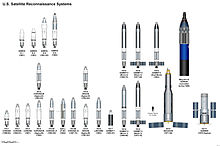
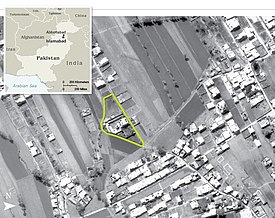
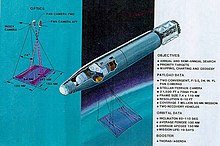
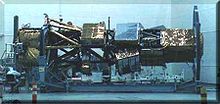

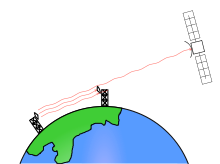
A reconnaissance satellite or intelligence satellite (commonly, although unofficially, referred to as a spy satellite) is an Earth observation satellite or communications satellite deployed for military or intelligence applications.
The first generation type (i.e., Corona[1][2] and Zenit) took photographs, then ejected canisters of photographic film which would descend back down into Earth's atmosphere. Corona capsules were retrieved in mid-air as they floated down on parachutes. Later, spacecraft had digital imaging systems and downloaded the images via encrypted radio links.
In the United States, most information available about reconnaissance satellites is on programs that existed up to 1972, as this information has been declassified due to its age. Some information about programs before that time is still classified information, and a small amount of information is available on subsequent missions.
A few up-to-date reconnaissance satellite images have been declassified on occasion, or leaked, as in the case of KH-11 photographs which were sent to Jane's Defence Weekly in 1984,[3] or US President Donald Trump tweeting a classified image of the aftermath of a failed test of Iran's Safir rocket in 2019.[4][5]
History[edit]
On 16 March 1955, the United States Air Force officially ordered the development of an advanced reconnaissance satellite to provide continuous surveillance of "preselected areas of the Earth" in order "to determine the status of a potential enemy’s war-making capability".[6]
During the mid-late 1950s, both the United States and the Soviet Union took interest into reconnaissance satellites. The United States began the CORONA project, which encompassed several series of launches starting in 1959 and ending in 72. This program was made a priority to photograph denied areas, replace the U-2, and due to public concern about a technological gap between the West and the Soviet Union.[7][8] It was expedited significantly after the shooting of a U-2 in 1960.[9]
Meanwhile, in the Soviet Union, a decree that authorized the development of sputnik apparently authorized a program for a satellite to be used for photo reconnaissance. This design evolved into Vostok, while another version became Zenit, which was an unmanned reconnaissance satellite. Zenit was launched from 1961 to 1994, however the last flight in 1994 was as a test payload.
Both the CORONA and Zenit satellites had to be recovered and used film, making them distinct from future reconnaissance satellites that could transmit photos without returning film to earth.[10][11]
Types[edit]
There are several major types of reconnaissance satellite.[12]
- Missile early warning
- Provides warning of an attack by detecting ballistic missile launches. Earliest known are Missile Defense Alarm System.[citation needed]
- Nuclear explosion detection
- Detects nuclear detonation from space. Vela is the earliest known.[citation needed]
- Electronic reconnaissance
- Signals intelligence, intercepts stray radio waves. SOLRAD is the earliest known.[13]
- Optical imaging surveillance
- Earth imaging satellites. Satellite images can be a survey or close-look telephoto. Corona is the earliest known. Spectral imaging is commonplace.
- Radar imaging surveillance
- Most space-based radars use synthetic-aperture radar.[citation needed] Can be used at night or through cloud cover. Earliest known are the Soviet US-A series.
Missions[edit]
Examples of reconnaissance satellite missions:
- High resolution photography (IMINT)
- Measurement and Signature Intelligence (MASINT)
- Communications eavesdropping (SIGINT)
- Covert communications
- Monitoring of nuclear test ban compliance (see National Technical Means)
- Detection of missile launches
On 28 August 2013, it was thought that "a $1-billion high-powered spy satellite capable of snapping pictures detailed enough to distinguish the make and model of an automobile hundreds of miles below"[14] was launched from California's Vandenberg Air Force Base using a Delta IV Heavy launcher, America's highest-payload space launch vehicle at the time.
On 17 February 2014, a Russian Kosmos-1220 originally launched in 1980 and used for naval missile targeting until 1982, made an uncontrolled atmospheric entry.[15]
Benefits[edit]
During the 1950s, a Soviet hoax had led to American fears of a bomber gap. In 1968, after gaining satellite photography, the United States' intelligence agencies were able to state with certainty that "No new ICBM complexes have been established in the USSR during the past year". President Lyndon B. Johnson told a gathering in 1967:[16]
I wouldn't want to be quoted on this ... We've spent $35 or $40 billion on the space program. And if nothing else had come out of it except the knowledge that we gained from space photography, it would be worth ten times what the whole program has cost. Because tonight we know how many missiles the enemy has and, it turned out, our guesses were way off. We were doing things we didn't need to do. We were building things we didn't need to build. We were harboring fears we didn't need to harbor.
During his 1980 State of the Union Address, President Jimmy Carter explained how all of humanity benefited from the presence of American spy satellites:[17]
...photo-reconnaissance satellites, for example, are enormously important in stabilizing world affairs and thereby make a significant contribution to the security of all nations.
Reconnaissance satellites have been used to enforce human rights, through the Satellite Sentinel Project, which monitors atrocities in Sudan and South Sudan.
Additionally, companies such as GeoEye and DigitalGlobe have provided commercial satellite imagery in support of natural disaster response and humanitarian missions.[18]
In fiction[edit]
Spy satellites are commonly seen in spy fiction and military fiction. Some works of fiction that focus specifically on spy satellites include:
- The OMAC Project
- Enemy of the State
- Body of Lies
- Ice Station Zebra
- Parmanu: The Story of Pokhran
- Patriot Games
See also[edit]
- Aerial reconnaissance
- Defense Support Program (U.S.)
- European Union Satellite Centre
- List of intelligence gathering disciplines
- List of Kosmos satellites
- National Reconnaissance Office (U.S.)
- Satcom on the Move
References[edit]
- ^ "Corona History". National Reconnaissance Office]. Archived from the original on 22 February 2014. Retrieved 15 February 2014.
- ^ "Corona Program". Mission and Spacecraft Library. Archived from the original on 7 August 2011. Retrieved 16 February 2014.
- ^ Wright, Michael; Herron, Caroline Rand (8 December 1985). "Two Years for Morison". The New York Times. Retrieved 16 February 2014.
- ^ Brumfiel, Geoff (30 August 2019). "Trump Tweets Sensitive Surveillance Image of Iran". NPR. Retrieved 1 September 2019.
- ^ Oberhaus, Daniel (3 September 2019). "Trump Tweeted a Sensitive Photo. Internet Sleuths Decoded It". Wired (San Francisco, Calif.). Wired. ISSN 1059-1028.
- ^ Erickson, Mark (2005). Into the Unknown Together – The DOD, NASA, and Early Spaceflight (PDF). Air University Press. ISBN 1-58566-140-6. Archived from the original (PDF) on 20 September 2009.
- ^ "Sputnik launched — History.com This Day in History — 10/4/1957". web.archive.org. 7 March 2010. Retrieved 15 May 2024.
- ^ Angelo, Joseph A. (14 May 2014). Encyclopedia of Space and Astronomy. Infobase. p. 489. ISBN 9781438110189
- ^
 This article incorporates text from this source, which is in the public domain: United States; Central Intelligence Agency; Ruffner, Kevin Conley (1995). CORONA America's first satellite program. Center for the Study of Intelligence, Central Intelligence Agency. p. xiii. OCLC 42006243.
This article incorporates text from this source, which is in the public domain: United States; Central Intelligence Agency; Ruffner, Kevin Conley (1995). CORONA America's first satellite program. Center for the Study of Intelligence, Central Intelligence Agency. p. xiii. OCLC 42006243.
- ^ Gorin, Peter (1997). "Zenit:Corona's Soviet Counterpart". In Robert A McDonald (ed.). Corona Between the Sun and the Earth: the first NRO reconnaissance eye in space. Bethesda, MD: The American Society for Photogrammetry and Remote Sensing. pp. 84–107.
- ^
 This article incorporates text from this source, which is in the public domain: "Discoverer 1". NASA. 14 May 2020. Retrieved 5 January 2021.
This article incorporates text from this source, which is in the public domain: "Discoverer 1". NASA. 14 May 2020. Retrieved 5 January 2021.
- ^ reconnaissance satellite, Infoplease, retrieved 17 February 2014
- ^ "The Navy's Spy Missions in Space". U.S. Naval Research Laboratory. April 2008. Archived from the original on 21 April 2019. Retrieved 21 April 2019.
 This article incorporates text from this source, which is in the public domain.
This article incorporates text from this source, which is in the public domain.
- ^ Hennigan, W.J. (27 August 2013). "Monster rocket to blast off from Pacific coast, rattle Southland". Los Angeles Times. Retrieved 16 February 2014.
- ^ Melissa Goldin (17 February 2014). "Fragments of Soviet-Era Satellite Burn Up in Earth's Atmosphere". Mashable. Retrieved 17 February 2014.
- ^ Heppenheimer, T. A. (1998). The Space Shuttle Decision. NASA. pp. 191, 198.
- ^ "The State of the Union Annual Message to the Congress". 1980 State of the Union Address. The American Presidency Project. Retrieved 11 April 2014.
- ^ "Commercial Satellite Imagery Companies Partner with the U.S. Geological Survey in Support of the International Charter "Space and Major Disasters"". USGS Newsroom. United States Geological Survey. Retrieved 4 April 2014.
Further reading[edit]
- Kupperberg, Paul (2003). Spy satellites. Rosen Publishing Group. ISBN 9780823938544. ISBN 0-8239-3854-9
- Richelson, Jeffrey (1990). America's Secret Eyes in Space: the U.S. Keyhole Spy Satellite Program. Harper & Row. ISBN 9780887302855. ISBN 0-88730-285-8
- Norris, Pat (2008). Spies in the Sky: Surveillance Satellites in War and Peace. Berlin; New York: Springer; Chichester, UK: In association with Praxis Publishing. Bibcode:2008spsk.book.....N. OCLC 154711855.
External links[edit]
- FAS Intelligence Resource Program – Imagery Intelligence (IMINT)
- Iran to Launch first spy satellite Archived 12 December 2005 at the Wayback Machine
- Egyptsat1 (MisrSat 1)
- Spaceports Around the World: Iraq's Al-Anbar Space Research Center
- Military Intelligence Satellites (NASA, remote sensing tutorial)
